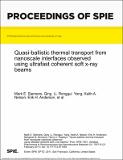Quasi-ballistic thermal transport from nanoscale interfaces observed using ultrafast coherent soft x-ray beams
Author(s)
Siemens, Mark E.; Li, Qing; Yang, Ronggui; Anderson, Erik H.; Murnane, Margaret M.; Kapteyn, Henry C.; Nelson, Keith Adam; ... Show more Show less
Download793716.pdf (1.074Mb)
PUBLISHER_POLICY
Publisher Policy
Article is made available in accordance with the publisher's policy and may be subject to US copyright law. Please refer to the publisher's site for terms of use.
Terms of use
Metadata
Show full item recordAbstract
Heat dissipation from a nanoscale hot-spot is expected to be non-diffusive when a hot-spot is smaller than the phonon mean free path of the substrate. Our technique of observing diffraction of coherent soft x-ray pulses allows for very high resolution (∼pm) of thermally-induced surface distortion, as well as femtosecond time resolution of dynamics. We successfully model our experimental results with a diffusive transport model that is modified to include an additional boundary resistance. These results confirm the importance of considering ballistic transport away from a nanoscale heat source, and identify a means of correctly accounting for this ballistic transport.
Date issued
2011-02Department
Massachusetts Institute of Technology. Department of ChemistryJournal
Proceedings of SPIE--the Society of Photo-Optical Instrumentation Engineers
Publisher
SPIE
Citation
Siemens, Mark E. et al “Quasi-Ballistic Thermal Transport from Nanoscale Interfaces Observed Using Ultrafast Coherent Soft x-Ray Beams.” Edited by Kong-Thon Tsen, Jin-Joo Song, Markus Betz, and Abdulhakem Y. Elezzabi. Ultrafast Phenomena in Semiconductors and Nanostructure Materials XV 7937 (February 2011): 793716 © 2011 Copyright Society of Photo-Optical Instrumentation Engineers (SPIE)
Version: Final published version
ISSN
0277-786X
1996-756X